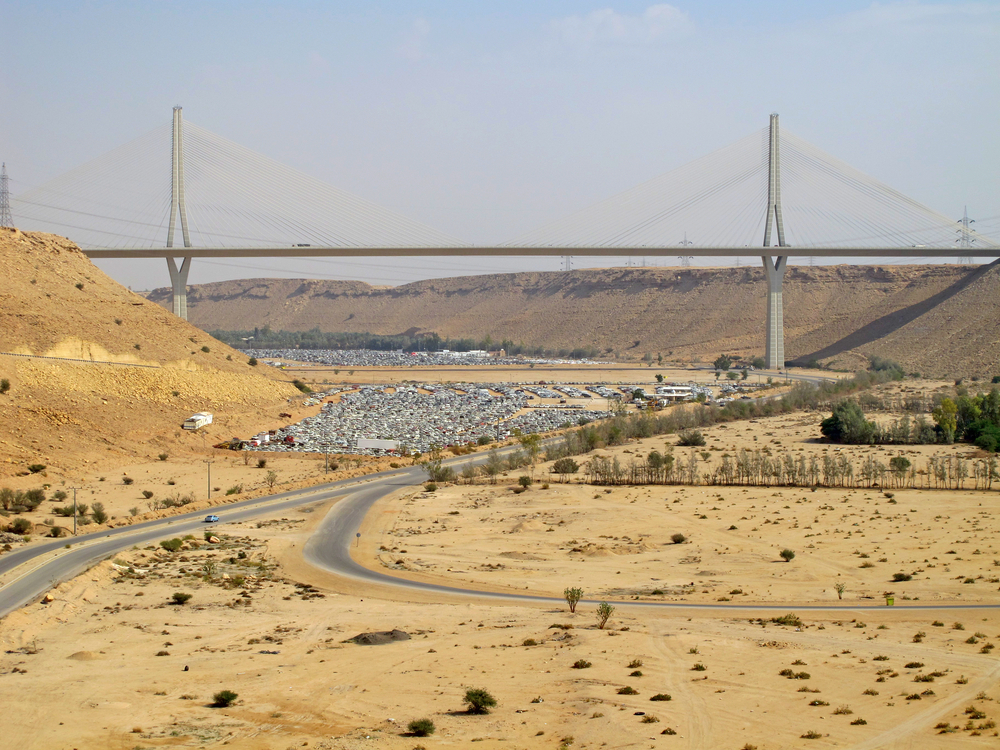Saudi Arabia’s roads less traveled leaving tourists behind
Photo: Road through the desert, Riyadh-Mecca highway in Saudi Arabia / Fedor Selivanov
Saudi Arabia's Commission for Tourism and National Heritage has improved the preservation efforts at key tourism sites, including ones that attract hundreds of thousands of hajj and umrah pilgrims each year, but the lack of highways and transportation is hampering the tourism industry.
Driving north for 336 km from Jeddah to Yanbu on Route 5, motorists unfamiliar with the Saudi Arabian highway may notice something unusual after passing the small city of Thuwal. There are no convenience stores, petrol stations or rest stops for most of the drive.
Motorists who do not read Arabic may also miss small signs directing them to exits for rest stops that are several kilometers off the highway. Indeed, some roadways and rural regions are so under-developed that tourists are banned from exploring them at all.
While major highways link the kingdom’s largest cities and secondary roads serve the small cities and towns, reaching villages can be more of a challenge, often accessible only by dirt roads. Once travelers leave the cities, they often have to organize their own petrol, food and water to reach their destination.
HAMPERING TOURISM
Although the kingdom’s Commission for Tourism and National Heritage has improved the preservation efforts at key tourism sites, including ones that attract hundreds of thousands of hajj and umrah pilgrims each year, the lack of highways and transportation is hampering the tourism industry, according to Dr. Erdogan Ekiz, a professor at King Abdulaziz University’s Tourism Institute.
“Highways and transportation are the tourism industry’s greatest weakness,” Ekiz told Salaam Gateway.
Billions of dollars have been spent on tourist sites with an emphasis on halal, religiously significant venues, but getting there can be a challenge. The government hopes that its 2016 budget allocations will help solve the transportation problems, but in the meantime, tour operators need to be creative in getting clients to places.
Fahad Al-Safh, operator of Explorer Tours, one of the oldest tourism companies in Saudi Arabia, told Salaam Gateway that a key route to the country’s most important archaeological site, Mada’in Saleh, cannot be used.
“The government closed the old highway to tourists and tour operators between Medina and Al-Ula,” he said.
The older Route 15 between Medina and Al-Ula is also a challenge, even for an experienced driver, but it is also an important artery for tour operators who pick up clients at the Prince Mohammad bin Abdulaziz International Airport for tours to Mada’in Saleh.
The lack of services and the government’s orders that tour operators avoid the old highway puts them at a disadvantage.
“There is a need for better government infrastructure, but they are doing it step by step,” Al-Safh said.
Saudi tourism officials will also be faced with increased burdens on religious destinations with the launch next year of the Umrah Plus program, which allows umrah pilgrims to extend their visits to religious landmarks outside of Medina and Mecca.
Adding to any tourist’s frustration is Saudi Arabia’s substandard public transportation. Bus routes are heavily used between Jeddah and Medina and onwards to Riyadh, and a short rail line between Riyadh and Dammam is popular, but there are no intra-city bus lines or long-distance routes that reach far-flung tourist sites. Saudis and expatriates rely on taxis, while bus coaches are decades old and cater to people who cannot afford a car.
That might change in western Saudi Arabia, however, with the Haramain Mecca-to-Medina high-speed rail line scheduled for completion in 2017. The government also allocated $6.4 billion for transportation and infrastructure in its 2016 budget, the bulk of the funds set aside for 2,000 km of new roads and railways and upgrades at important tourist destinations such as Yanbu, Ras Al-Khair and Jubail, according to the Saudi Ministry of Transport.
In the meantime only the adventurous tourist will travel alone instead of relying on tour operators’ chartered buses to get around.
“Highway improvements will be made, but transportation will continue to be a big challenge,” Ekiz said.
© SalaamGateway.com 2016

Rob L. Wagner